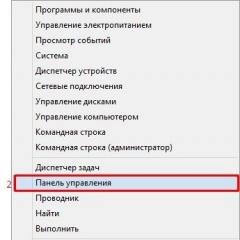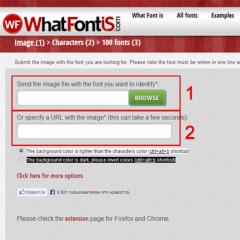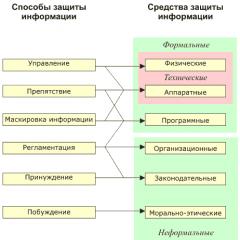Setting up the windows 10 tray. How to instantly hide (display) icons on the Windows desktop. Enable or disable icons
This article shows you the steps you can use to control the display of icons in the notification area in the Windows 10 operating system
The notification area, or system tray, is the rightmost area of the taskbar that houses the system clock and application notification icons. The two standard notification icons are the icons for and Network and Sharing Center. Hovering the mouse pointer over an icon in the notification area displays a pop-up line (or window) containing information about the status of the application or component of the icon.
To manage an application represented by an icon in the notification area, right-click on its icon, which will open the context menu for that application. The options on this menu will vary from application to application; most of them provide access to basic application management operations.
You can optimize the notification area by adjusting the display settings for system icons (clock, volume control, Network and Sharing Center) and application icons.
The notification area can contain both system icons and application icons. Application icons are placed in the notification area for several reasons. Some programs are managed by the operating system itself, and their icons are periodically displayed in the notification area when there are notifications from these applications. Other types of programs, such as antivirus applications, are configured to start automatically and then run in the background.
The display of program icons can often be controlled using the customization tools provided by their respective applications, but provides a common interface for controlling the display of icons in the notification area for each individual application that places an icon in that area.
Controlling the display of icons in the notification area
To manage the options for displaying icons in the notification area, open the taskbar settings settings, to do this, right-click in an empty area of \u200b\u200bthe taskbar and select the item in the context menu that appears. Taskbar Options or sequentially open:
Start ➯ Settings ➯ Personalization ➯ Taskbar
![]()
This will open the Windows Settings application under the Personalization category on the Taskbar tab. On the right side of the window, in the section notification area two links are provided to control the display of icons in the notification area:
![]()
To enable the display of all icons in the taskbar notification area, click on the link Select the icons displayed in the taskbar
![]()
In the next window, set the toggle to On.
![]()
To customize the icons, select the radio button Always show all icons in the notification area to the off position. and for each icon, use the corresponding radio buttons.
![]()
To turn system icons on and off, click on the link Turning system icons on and off
![]()
In the next window, use the switches to enable or disable the system icons you need.
![]()
Using the steps above, you can control the display of icons in the notification area in the Windows 10 operating system
Good to everyone.
Icons in the Windows notification area and the ability to hide them are nothing new to anyone. When there are a lot of them, hiding icons is quite a convenient feature. And they take up less space, leaving only frequently used program icons within visibility.
In this article, I want to show you how you can set up the permanent visibility of the icons you need, as well as the constant stealth of all others, with lightning speed. Without getting into the Windows settings!
If you look at the screenshot above (or on your computer), you will see an up arrow to the left of the icons. When you click on it, all hidden icons are displayed. If the program that you regularly use is located there, then it is not very convenient to make extra mouse clicks, first on the arrow, then on the icon itself.
Therefore, we will display the desired icon, for example, Evernote, in the zone of constant visibility. To do this, click on the up arrow, left-click the icon and drag it to the visible part of the notification area. Now release the left mouse button, the icon will be permanently visible.


Now Evernote is always in sight and you don’t have to climb into a hidden area for it.
And if you want to hide unnecessary icons? No problems. Press the left mouse button on the icon and drag it to the up arrow. After that, release the mouse button. Ready!
So, let's begin. Right click on the taskbar. Next, click on the "Properties" tab.
In this window, click on the "Settings" button.

In the settings window, check the box "Always show all icons and notifications on the taskbar" and click "OK".

After these settings, look at the bottom of the screen (in the tray) and see that all hidden icons are displayed on the taskbar.

As you can see, there is nothing difficult in setting up the display of hidden icons.
What to do if you have no hidden icons from the taskbar at all and you cannot make settings.
Go to the Start menu and type Regedit in the search bar to get to the registry editor. Let's continue down this path HKEY_CURRENT_USER\Software\Classes\Local Settings\Software\Microsoft\Windows\CurrentVersion\TrayNotify. Right-click on the “TrayNotify” folder and click on the “Export” tab, save this folder on the desktop - this is necessary for safety, so that in case of problems you can import the “TrayNotify” folder back.

Once you have opened the "TrayNotify" folder, find the "IconStreams" parameter and delete it.


Do not worry, after the process is completed, everything will disappear from the desktop except for the Task Manager window. Click on the "File" item and select "New task (execute)".
The notification area (sometimes referred to as the “system tray”) in Windows 10 is located on the left side of the taskbar, and it includes a series of icons for accessing various functions and options. In the notification area, you will find mostly system icons for Windows 10, including those for the update center, date and time, sound, network, and onedrive storage. But some apps can also add icons to access various features.
Windows automatically hides many icons in the notification area to free up space on the taskbar. To see all of your notification area icons, click the up arrow to the left of the notification area icons. But the problem is that the notification area can quickly get crowded, but luckily Windows 10 includes a few options to let you choose which icons to display on the taskbar. Not all applications run in the foreground. Some sit quietly in the background, doing the work for you via a notification area icon - also often (but apparently incorrectly) known as the system tray.
Windows helps you manage these notifications by controlling which icons appear on the taskbar and whether certain system icons always appear. If you are looking for a way to customize the notification area icons on the taskbar in Windows 10, then in this article you will read how easy it is to use the steps to do it. The notification area is located on the right side of the Windows 10 taskbar and it is the application icons that provides you with notifications and status such as Windows Updates, Emails, Reminders, Network, Security and more.
Customize Notification Area Icons on the Taskbar in Windows 10
The notification area is an integral part of the Windows operating system and users can customize it to suit their needs. In this guide, you'll read about how to choose which app and notification icons to display in the notification area on the Windows 10 taskbar.
Here's how to do it:
Note: in case you choose to hide notifications and icons, you won't see any update notifications and you won't be able to change the notifications for that particular app.
Choose which icons will appear on the taskbar
1. To do this, open Settings -> Personalization -> Taskbar (on the left) and click on the icon that is displayed on the taskbar.
2. Here you will see an option to always show all icons in the notification area. Enable (Show) or Disable (hide) application icons will appear in the taskbar notification area.
In addition, you will get a list of all applications. You can also select an application manually.
In case you want to enable or disable the "system" icon. To do this, in the notification area, you will see a link on how to turn the System icon on or off.
From the list, select the System icon you want it to appear in the notification area.
![]()
This is a fairly simple way to customize the icons in the notification area on the taskbar in Windows 10, and you can try it yourself.
Remove startup programs from the notification area
If you really want to clear the notification area, you can completely close applications and prevent them from automatically starting with your computer, which will free up some system resources.
But if you don't want to close all applications running in the notification area, as many of these applications are useful for one reason or another. For example, many hardware drivers include hardware update utilities that run in the background and remain in the system tray. Or some apps may let you sync your files in real time, such as Dropbox. These are the kinds of applications that you want to keep open at all times.
To close applications running in the notification area, you can simply right-click and select "Exit" or "Quit". If you want to disable programs, you can find a setting that determines whether or not an icon is displayed in the notification area, or whether it starts working with Windows.

Windows 8 and 10 also have an integrated startup manager built into the Task Manager. With it, you can quickly manage the applications that run when you log on to your computer. In Windows 7, this manager is part of the msconfig program tool, not the Task Manager.
Some users of the Windows 10 system are faced with a situation where, for some unknown reason, the sound or language change icon in the tray disappears.
The system tray, also known as the notification area, is the right place on the taskbar, where the clock and date, network, power, volume control, and notification center icons are located. Often the problem with icons is due to disabling their display in the system settings.
Below is the easiest way to customize system tray icons. Right-click on the clock and select "Set notification icons" in the context menu.

In the “Notifications and actions” section, click on the link “Turn system icons on and off” and in the window that opens, use the switches to select the system icons that will be displayed in the notification area.

An additional solution to the problem with the loss of the sound or network icon. If the above option did not help return the icon, then the problem may be in the sound card driver. To see if the sound devices are working properly, you should right-click on the “Start” menu and go to the “ ” item. If the driver does not work correctly, it should be updated automatically or manually.



